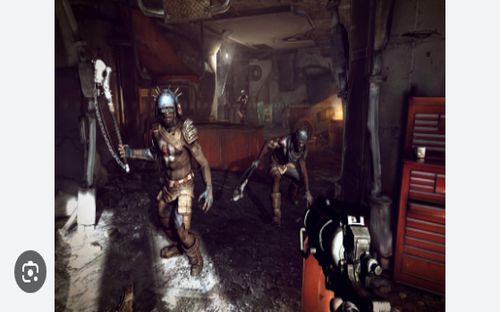The post-apocalyptic first-person shooter Rage, created by id Software and released by Bethesda Softworks, combines classic gunplay, exploration, and vehicular action in a vast, dusty globe devastated by an asteroid strike. Rage was notable when it was first released because it made use of the id Tech 5 engine, which produced expansive, intricate settings with a violent yet exquisite look. As a survivor of the Ark program, a network of subterranean bunkers constructed to protect mankind, the player enters a world that has obviously moved on without them.
In Rage, the environment is just as much a character as any player. The Wasteland is teeming with dangerous bandits, mutant beasts, abandoned vestiges of the old world, and improvised communities. The landscapes are strewn with twisted metal, abandoned technology, and graffiti-stained concrete, and the visual direction mainly relies on a gritty, rust-colored palette. These components work together to give the impression that each location is a moment in time of civilization attempting to stave off the end of the world.

The shooting mechanics in the game are one of its strongest points. Guns have a pleasant impact that makes every encounter thrilling, and they feel heavy and strong. Due to its stealthy lethality and practicality when outnumbered, the Wingstick, a throwing weapon resembling a boomerang, swiftly gained popularity among fans. Rage’s fast-paced, violent combat encourages players to flank opponents, stay on the move, and employ a variety of tools and weapons. Fights are dynamic and surprising because enemies don’t just run at you; they also duck, evade, and use cover.
In Rage, vehicles serve as more than simply a means of transportation; they are essential survival tools. Your vehicle, which may be upgraded and equipped with weaponry, serves as both your mobile armament and escape strategy. The open environment of the game is dotted with vehicle combat events and races, which give the experience a Mad Max-style rush. You may get improvements by winning races, and traveling between villages frequently results in road fights that challenge your reflexes and strategic thinking.
Rage is not totally freeform, even if it provides a wide, open-world framework. Within their zones, missions and plot beats are largely linear, but there is considerable backtracking and setting reuse. Although the game never truly embraces the richness of an RPG, side missions and mini-games aid in breaking up the main quest line. Compared to truly open-world games, it maintains a tighter hold on advancement and plot while still allowing ample room for exploration and experimentation.
Although adequate, the tale isn’t the primary draw. Although it adheres to well-known post-apocalyptic clichés—warring groups, eerie government relics, and the appearance of a secret threat—the gameplay is what really makes the experience memorable. The language accomplishes its goal without going into too much detail, and the characters you encounter are vibrant and well-acted, but rather undeveloped. The setting has an air of mystery that alludes to a more extensive plot, but Rage doesn’t always carry out those suggestions.



At debut, Rage’s graphics were a technological wonder thanks to megatexture technology, which produced smooth topography and incredibly realistic settings without obvious loading windows. But it wasn’t without problems. A typical issue was texture pop-in, which occurred when the engine sometimes found it difficult to keep up with the action on consoles. The game’s visual identity is still one of its most memorable features in spite of these problems.
System Requirements OF The Rage Highly Compressed PC
| Ram | 2 GB RAM |
|---|---|
| Processor | Intel Pentium II |
| Accessories | Keyboard, mouse, and speaker |
| Graphics card | NVIDIA GeForce 8800 |
| Windows | Xp, 7, 8, 8.1, 10, and 11 |
| Free disk space | 25 GB |
Rage’s sound design successfully blends in with its gloomy environment. An engrossing auditory world is produced by the clatter of gunfire, the hum of motors, and the background noise of the Wasteland. Players are helped to anchor themselves in the setting by the soundtrack’s subtlety, which frequently lets ambient sounds take center stage. All of the voice acting is excellent, and the characters are given life by powerful performances even though they are not well written.
Rage has a strong ancestry to previous id Software games, especially in its focus on fluid fighting and ambient narrative. Rage established its own niche by fusing driving and shooting in a seamless, tactile universe, even if it fell short of Doom or Quake’s crucial heights. Rage’s sophisticated gunplay and unique visual aesthetic help it escape seeming like a clone, despite the obvious influence of Mad Max, Fallout, and even Borderlands.
In hindsight, Rage was an ambitious game that accomplished certain goals but fell short on others. Even if it faltered in areas like story depth and world involvement, its unique combination of vehicle-based exploration, high-octane combat, and technological innovation set it apart. Rage offers a snappy, evocative journey through a world that seems harsh, unpolished, and oddly alive to players who are prepared to ignore its flaws.


